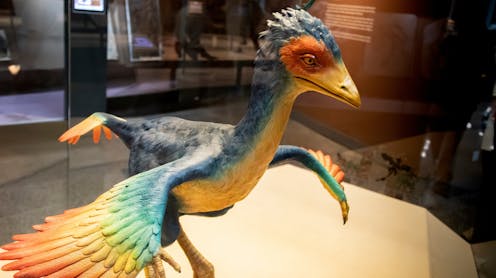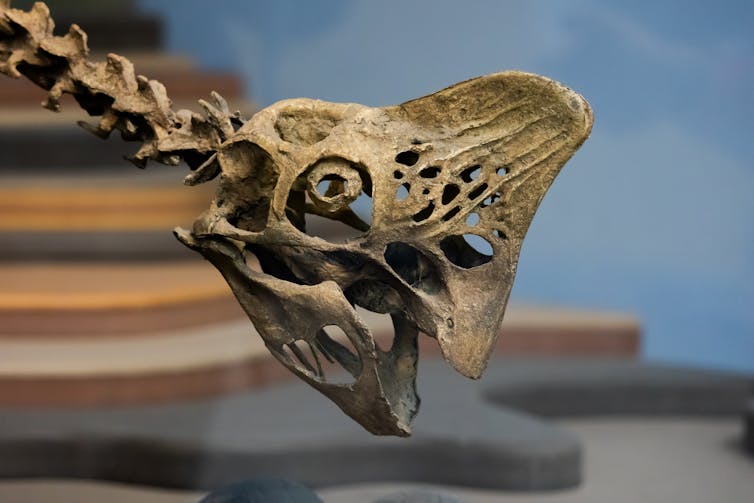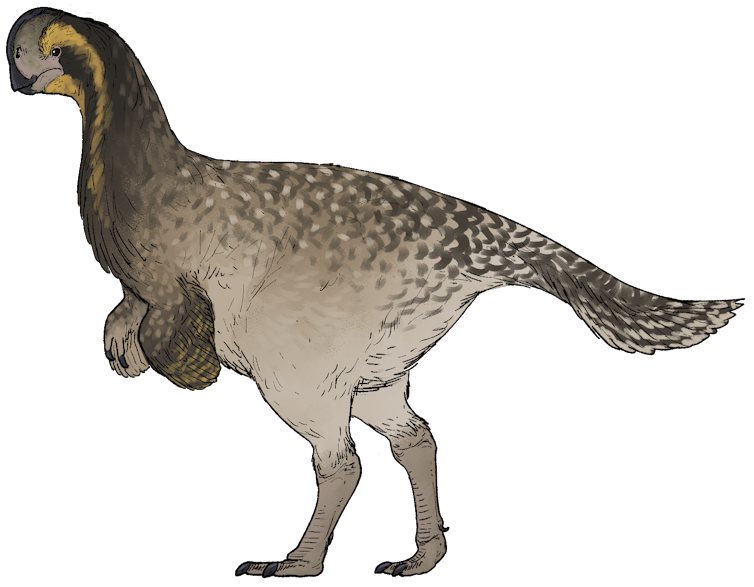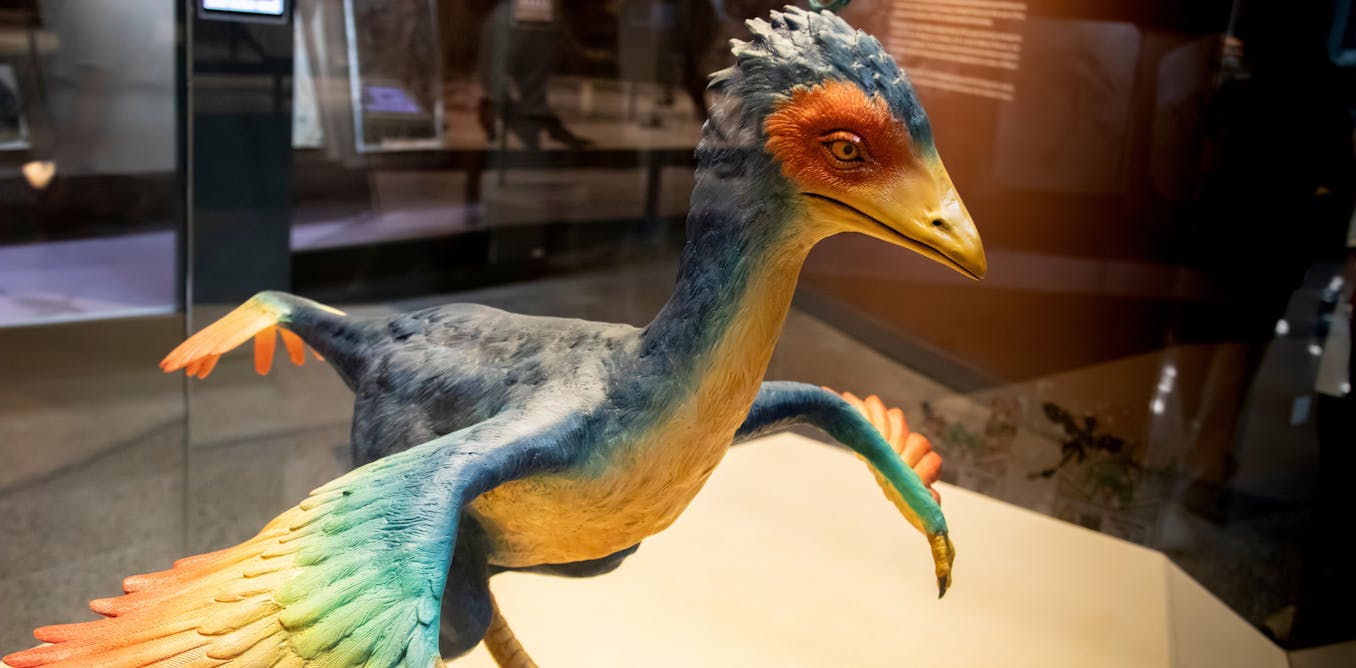
Oviraptorosaurs are weird dinosaurs, which look a bit like flightless birds. But these ancient animals aren’t just funny looking fossils. As my team’s new research shows, they can help us understand how our own forelimbs evolved and challenge what scientists think about the T rex.
Covered in feathers and equipped with a strong, sharp beak, oviraptorosaurs ranged in size from a house cat to a giraffe. They could easily be mistaken for birds if not for the sharp claws on their hands. The oviraptorosaurs lived during the Cretaceous period (between 145 and 66 million years ago) and belonged to a group of dinosaurs called theropods. This is a group of mainly meat-eating dinosaurs with hollow bones that includes the T rex and velociraptor.
Theropod dinosaurs and humans share a common feature: we walk on two legs and use our front limbs for functions other than walking. Although some dinosaurs – the birds – stretched their forelimbs into wings and used them for flight, others, shrunk them instead. Short forelimbs, missing one or more fingers are most famous in the T rex, but many other theropods also evolved shorter arms and hands.

vipinrajmg/Shutterstock
The widespread view among scientists of their shrunken forelimbs as “useless” comes from a 1979 paper. It argues evolution selected for increased head and hindlimb size in the T rex and the arms became smaller as an evolutionary byproduct. So, when my team at the University of Edinburgh analysed patterns of arm evolution in a group of oviraptorosaurs, we expected to find that forelimb reduction and finger loss would be linked.
Instead, we found the opposite. Our study is the latest example of growing evidence that the reduced forelimbs of certain theropods retained some kind of function. Until now, many palaeontologists assumed dinosaurs which evolved shorter arms and lost their fingers did so because they weren’t using them.
Oviraptorosaurs are the perfect group to study finger loss in theropods. Although modern birds did not evolve directly from oviraptorosaurs, they share many features with them. Oviraptorosaurs had toothless beaks, they were covered in feathers, and they sat on carefully constructed nests, with their eggs arranged in neat rings and partly buried. Most of these dinosaurs had long arms with three clawed fingers on each hand, perfect for grasping prey. With one exception.
Oksoko avarsan had stumpy arms and only two functional fingers. It lived in Mongolia during the Late Cretaceous period (about 72-66 million years ago) and would have shared its habitat with a gigantic relative of the T rex called Tarbosaurus. Oksoko did – technically – have a third digit but it was a useless leftover from a time when their ancestors needed all three fingers. In fact, Oksoko’s hands and forelimbs are far more similar to a T rex or a Tarbosaurus than to any of its oviraptorosaurian cousins.

Ddinodan/Wikimedia, CC BY-NC
It’s important to understand how theropod forelimbs evolved because they are some of the only animals, alongside humans, to become bipedal. This means they no longer rely on their forelimbs for moving around, whether that’s by walking, climbing, or flying. Their arms were free to evolve new functions. Many of them used their long arms and fingers for grasping. Others, like Oksoko, explored different and more specialised functions.
My team’s research, which analysed how the length of each arm bone changed over time, shows that these dinosaurs lost their third finger in a separate process to the shortening of their arms. This goes against the idea that their arms were functionless. If their forelimbs shrunk because the oviraptorosaurs were not using them, their fingers and forelimbs should have become shorter at the same time. Instead, their arms seem to have shrunk first.
Previous research shows one group of oviraptorosaurs, called the Heyuanninae, expanded their range during the Late Cretaceous (about 100-94 million years ago). They moved from the area that is now southern China into the Gobi Desert in northern China and southern Mongolia. The reduction in arm length coincided with this expansion in their range.
Then Oksoko lost its third finger. Although some other closely related oviraptorosaurs had relatively short third fingers, in none of them was it as reduced as in Oksoko.
Forelimb reduction and finger loss in this group of dinosaurs could have been caused by the new habitat. Once they had moved into the Gobi Desert, they would have come up against new survival challenges. For example, they might have had to adapt to new food sources or different predators. Something about their new habitat favoured dinosaurs with shorter arms and fewer fingers, causing them to evolve their stumpy, two-fingered forelimbs.
We think they started using their arms for a whole new purpose. It’s possible Oksoko used its arms for digging. Oksoko might have lost its third finger, but its first finger is another story. This digit is thick and strong-looking, with a large claw on the end. We can see scars and ridges where its muscles used to be attached to its bones. These show that Oksoko had strong arms.
Rather than reaching and grasping like other oviraptorosaurs, Oksoko could have used its small but mighty forelimbs for scratch-digging. This could have been useful for finding food, such as plant roots and burrowing insects, or for building nests in the ground.
The holotype fossil (the fossil which leads to the naming of a new species) of Oksoko was the most important fossil in our analysis. Originally found by poachers in Mongolia, this fossil was nearly lost to science. Authorities rescued it at the border of Mongolia in 2006 and it was taken to the Institute of Palaeontology, but wasn’t fully studied until 2020. It was Oksoko’s strange two-digit forelimbs that made us want to investigate finger evolution.
Despite the similarities in the size and shape of their forelimbs, it unlikely that T rex and Oksoko used their arms for the same thing. Oksoko was a small herbivore. T rex was a giant carnivore – it was so massive that it couldn’t have reached the ground to dig, even if it tried. But Oksoko shows us that theropod forelimbs can get shorter and lose digits without becoming functionless. And that begs the question: are T rex’s arms as useless as they’re often portrayed?
My team’s new research shows that our initial assumption – that forelimb and digit reduction are caused by function loss in oviraptorosaurs – is probably wrong. Instead, arm-shrinking and finger loss seem to be caused by adaptation to a new environment and the adoption of a new function. This is an example of how evolution can mould forelimbs to suit different habitats and uses.
It is also a step forward in understanding how theropods evolved such an amazing diversity of forelimb shapes and sizes.
![]()
Milly Mead receives funding from the Swedish Research Council.



